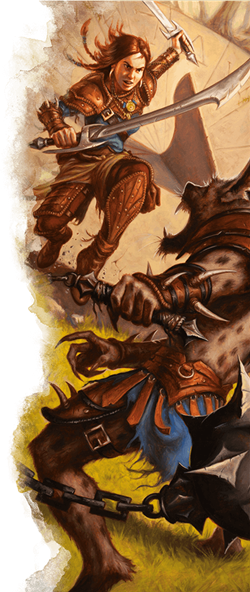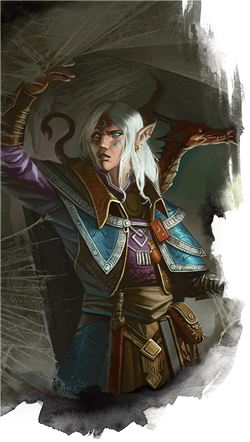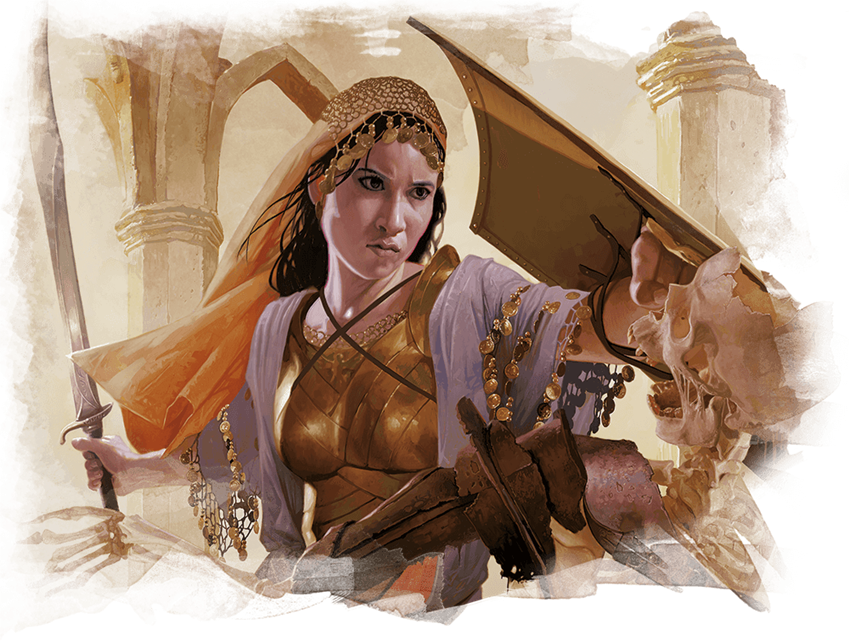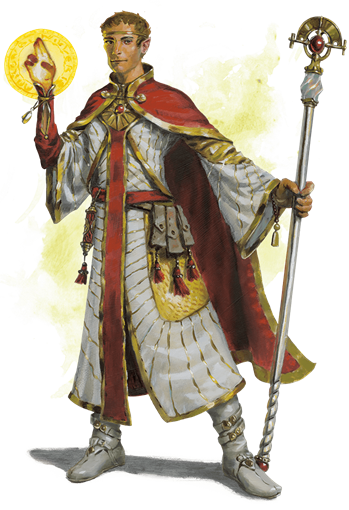 D&D Beyond teamed up with The Role Initiative at PAX East last weekend, and together we helped people create and print out characters to play in dozens of D&D Adventurers League games. Practically our entire team was there, from web developers to graphic designers. Lauren Urban, our community manager, and I flew down from Seattle to put boots on the ground and join our team to help out in person! While there, though, I noticed that a lot of people were asking the same questions: “How do I make a character that’s Adventurers League legal?”
D&D Beyond teamed up with The Role Initiative at PAX East last weekend, and together we helped people create and print out characters to play in dozens of D&D Adventurers League games. Practically our entire team was there, from web developers to graphic designers. Lauren Urban, our community manager, and I flew down from Seattle to put boots on the ground and join our team to help out in person! While there, though, I noticed that a lot of people were asking the same questions: “How do I make a character that’s Adventurers League legal?”
It’s a good question. Characters in the D&D Adventurers League have a few specific restrictions on how they can be built, both to keep the game more accessible to newcomers and to prevent people from creating exceptionally unbalanced characters. The Adventurers League makes these restrictions and other AL-specific rules clear in their Players Guide, which is updated every season. Still, the D&D Beyond team thinks it should be easier to make characters that are AL-legal without any hassle. That’s why our short-term plans include creating Adventurers League character validation, which will allow you to easily create AL-legal characters without memorizing the specific rules.
This is no secret; it’s been on our public Feature Roadmap for the past few months, and it’s one of the next projects our developers are going to tackle—right after they finish projects like the Mobile Character Sheet beta, and the Encounter Builder. I’m not a developer, so I can’t say exactly how this feature will look when it’s all set up, but I’m confident that it will make it easier than ever to make an AL-legal character. Next time I’m at PAX Unplugged, I hope I’ll be able to just flick a switch and turn off all AL-illegal options for new players, rather than running down a list of things that they’re not allowed to do when building their characters.
In the meantime, though, I want to show you how to make an Adventurers League-legal character on D&D Beyond. If you’re new to AL, this guide will walk you step-by-step through the character creation process, and explain the AL-specific character creation rules, too. While some of these rules can be broken with special permission granted by the administrators in the form of certificates (or "certs") for completing special in-game objectives, a player starting completely fresh must follow these guidelines. The following advice is up to date as of Season 8 of the D&D Adventurers League.
Begin at 1st Level
The D&D Adventurers League covers all levels of play, ranging from tier 1 (levels 1 through 4) to tier 4 (levels 17 through 20). However, new characters must begin at 1st level. Your Adventurers League experience will see your character grow from a dime-a-dozen adventurer into a truly fearsome warrior of the Realms. You don't have to start your character over with every new storyline season, though. If you started at 1st level in Chult (Season 7) and rose to 6th level during that time, then you could take that character to Waterdeep (Season 8) and continue adventuring without a hitch.
Player’s Handbook +1
 The most important rule in the D&D Adventurers League is this: when building a character, you can only choose your race, class, feats, and starting spells from the Player’s Handbook and one other source. These sources are:
The most important rule in the D&D Adventurers League is this: when building a character, you can only choose your race, class, feats, and starting spells from the Player’s Handbook and one other source. These sources are:
- Elemental Evil Player’s Companion
- Sword Coast Adventurers Guide
- Volo’s Guide to Monsters
- Xanathar’s Guide to Everything and The Tortle Package (these two sources are counted as a single source)
- Mordenkainen’s Tome of Foes
There are a few notable exceptions to this rule, such as backgrounds, which are all available for use regardless of source. As far as spells are concerned, your starting spells and all spells gained through leveling up are restricted to the spells found in the Player’s Handbook and your +1. Wizard characters can get around this rule by scribing spells found on spell scrolls into their spellbook (see "Your Spellbook").
If you want more information on the PHB +1 rule, check out this Aid Another article.
Restricted Races and Classes
 The first rule some people bump into is related to their choice of race and class. This is an offshoot of the PHB +1 rule, but it’s worth calling out on its own: there are just some races and classes that you can’t play in the D&D Adventurers League, at least not without special permission. Unfortunately, some of these races and classes are available for free in D&D Beyond, and some of the people who I helped build characters this weekend were confused by it.
The first rule some people bump into is related to their choice of race and class. This is an offshoot of the PHB +1 rule, but it’s worth calling out on its own: there are just some races and classes that you can’t play in the D&D Adventurers League, at least not without special permission. Unfortunately, some of these races and classes are available for free in D&D Beyond, and some of the people who I helped build characters this weekend were confused by it.
Let’s set the record straight; these are all the races and classes you can’t in Adventurers League games, and why:
- Aarakocra (Elemental Evil Player’s Companion). Unfortunately, the high-flying bird-people known as aarakocra aren’t legal for AL play because of their flying speed. While magic items and spells that grant characters flight like winged boots and fly are AL-legal, races that grant characters flight are considered overpowered, and have thus been banned from AL play. This is because most low-level adventures can be trivialized by a party of all-flying (or even mostly-flying) characters, and players looking to game the system can easily do so by playing flying races.
- Variant Tiefling: Winged Tiefling (Sword Coast Adventurers Guide). Just like the aarakocra, winged tieflings have the ability to fly at 1st level. They can’t be played for all the reasons listed above.
- Eladrin (Variant; Dungeon Master’s Guide). Not to be confused with the eladrin presented in Mordenkainen’s Tome of Foes, the eladrin presented as an example of how to create a subrace in the Dungeon Master’s Guide is not AL-legal. This version of the eladrin subrace is listed as “Eladrin (Variant)” in D&D Beyond.
- Aasimar (Variant; Dungeon Master’s Guide). Likewise, while the version of the aasimar race presented in Volo’s Guide to Monsters is AL-legal, the aasimar variant used in the Dungeon Master’s Guide as an example of how to create a race isn’t available for AL play. This version of the aasimar race is listed as “Aasimar (Variant)” in D&D Beyond.
- Death Cleric (Dungeon Master’s Guide). The Death domain is a cleric subclass presented in the Dungeon Master’s Guide as an option for villains and evil characters. It is, however, not AL-legal, since the Dungeon Master’s Guide isn’t a permitted “+1” book.
- Oathbreaker Paladin (Dungeon Master’s Guide). Just like all other player options presented in the Dungeon Master’s Guide, the Oathbreaker paladin subclass is not allowed in Adventurers League games.
While some other races and classes may be restricted based on which book you chose as your “+1,” these are the only totally restricted options.
No Rolling for Ability Scores
The now-iconic “roll 4d6, drop the lowest” method of choosing ability scores isn’t allowed in D&D Adventurers League. In fact, rolling for stats is verboten, period! You have two options for generating your ability scores in AL games. The first is Point Buy, in which all of your ability scores start at 8 and you spend points to raise your scores to their starting value. The second is Array, in which you allocate six predetermined scores to your six abilities.
These standardized ability score generation methods are in place to keep characters roughly balanced against one another. It also helps characters travel between different DMs without hassle. If someone shows up to your table with an 18 in every stat, who you are to say that they didn’t get lucky and legitimately rolled them?

Picking Feats and Spells
The trickiest part of following the PHB +1 rule is when you choose your feats and spells. Unfortunately, D&D Beyond currently doesn’t have an option to restrict feats and spells by source in the character builder or the digital character sheet. That means that, when you go into your character sheet to choose your spells, you are presented with a list of all spells that your character can take—regardless of source. Since there are four books with spells in them—Player’s Handbook, Elemental Evil Player’s Companion, Sword Coast Adventurers Guide, and Xanathar’s Guide to Everything—that means that you’re always going to be presented with spells that could break the PHB +1 rule.
If you’re choosing your spells at 1st level and don’t know which spells are legal when you’re picking them in the digital character sheet, your best option is to go to the Game Rules drop-down menu on the top of the page, and then next to the Spells header click on “View All.” This will bring you to the Spells menu. Then, click on “Show Advanced Filters” and click on the “Source” bar at the very bottom of the filters list. When you click on this bar, it will bring up a list of all official D&D books. Then, select the Player’s Handbook and your +1 book to determine which spells are available to you.
If you want to use filters super stylishly, you can also go up to the “Spell Level” filter and choose “1st level” to only have the list show you 1st-level spells.
Voila, a Character!
 Keep these rules in mind while building your character, and you should have an AL-legal character no problem. If you need simpler advice for new players, I have three quick guidelines that helped me when new players at PAX East asked me for advice:
Keep these rules in mind while building your character, and you should have an AL-legal character no problem. If you need simpler advice for new players, I have three quick guidelines that helped me when new players at PAX East asked me for advice:
- Don’t pick races with a flying speed (like aarakocra)
- Use Point Buy or the Array to choose your ability scores
- Make sure all your spells come from the Player’s Handbook and only one other book
These simplified rules worked because most of the new players I met at PAX only had access to the free content, which is exclusively from the Player’s Handbook and the Elemental Evil Player’s Companion, so there was no chance of breaking the PHB +1 rule. Also, by clicking on the “Quick Build” option in the character creation tool, they were able to have reasonably powerful characters ready to play in just minutes; and since Quick Build uses only resources from the Player’s Handbook, the results are guaranteed not to break the PHB +1 rule, too.
What characters have you played in the D&D Adventurers League? Share stories of their exploits with us in the comments below!
 James Haeck is the lead writer for D&D Beyond, the co-author of Waterdeep: Dragon Heist and the Critical Role Tal'Dorei Campaign Setting, the DM of Worlds Apart, and a freelance writer for Wizards of the Coast, the D&D Adventurers League, and Kobold Press. He lives in Seattle, Washington with his partner Hannah and their feline adventurers Mei and Marzipan. You can usually find him wasting time on Twitter at @jamesjhaeck.
James Haeck is the lead writer for D&D Beyond, the co-author of Waterdeep: Dragon Heist and the Critical Role Tal'Dorei Campaign Setting, the DM of Worlds Apart, and a freelance writer for Wizards of the Coast, the D&D Adventurers League, and Kobold Press. He lives in Seattle, Washington with his partner Hannah and their feline adventurers Mei and Marzipan. You can usually find him wasting time on Twitter at @jamesjhaeck.








-
View User Profile
-
Send Message
Posted Apr 4, 2019It doesn't really provide a problem for data validation. Either the player has Elemental Evil as their +1 source for Adventurers League, or they have Xanathar's Guide to Everything as their +1 source for Adventurers League.
If they use the prior, they will have no access to the feats or subclasses from the latter.
If they have feats or subclasses from the latter, they did not choose the prior.
-
View User Profile
-
Send Message
Posted Apr 4, 2019If D&D Beyond really wants to embrace AL and innovate, they need to make this THE hub for finding and joining an AL-sanctioned table, complete with campaign binding and character submission/management. AL is severely lacking in the tools department, and frankly isn't really worth the time if you have a couple of friends to play with. Removing barriers for entry should be job 1 of both WotC and all licensed/sanctioned partners.
-
View User Profile
-
Send Message
Posted Apr 4, 2019The point is that the same spell is in both ee and xgte. But dndbeyond.com lists it as an ee spell. It would be wrong to restrict access to ee spells if my phb+1 is xgte as xtge includes all ee spells
-
View User Profile
-
Send Message
Posted Apr 4, 2019I would add that picking an arcane caster may mean that you cannot afford to scribe spells into a spellbook or your book of ancient secrets so it's usually better to play a martial class.
If playing Curse of Strahd there is a mechanism that directly discriminates against non-lawful alignments so always create a Lawful Neutral, Lawful Good or Lawful Evil character. Play it how you want as in 5e alignment is ignored except for one bit in this adventure that will cost you your character if not of a Lawful alignment!
It's stupid but you have been warned!
-
View User Profile
-
Send Message
Posted Apr 4, 2019It's worth noting that with the appropriate DM quests completed you can create a death domain cleric or an oath-breaker paladin.
-
View User Profile
-
Send Message
Posted Apr 4, 2019Please add al log tracking as well as unlock and tp tracking.
-
View User Profile
-
Send Message
Posted Apr 4, 2019I agree with you DragonSilvestri that sources listed on all these things would make this process infinitely easier. Even better would be if there was a toggle at the beginning of creation like there is for Homebrew, Eberon, MTG, etc. for every source you have access to that way you can just select PHB (which should be automatically on) and your 1 other source so only those options show up during creation.
-
View User Profile
-
Send Message
Posted Apr 4, 2019Is there any special concerns, considerations when creating an AL character starting off at a higher level? Is there any concerns about starting off with magical items?
-
View User Profile
-
Send Message
Posted Apr 4, 2019We ran with DnDBeyond at Gary Con XI for the quick and easy generation of characters, instead of printed pre-generated characters, in the Adventurers League room. It was a big hit!
-
View User Profile
-
Send Message
Posted Apr 4, 2019You cannot start an AL character higher than 1st level normally. There are a few certs and quests that allow this, but those are earned in game. Same with magical items.
-
View User Profile
-
Send Message
Posted Apr 4, 2019Not to mention earning certs that bypass restrictions, like the Batiri goblin cert from season 7. Those will need to be accounted for.
-
View User Profile
-
Send Message
Posted Apr 4, 2019I'd like to also point out that there are limitations to D&D Beyond and AL meshing perfectly together without requiring enabling homebrew content. A few of them are outlined below:
I love D&D Beyond, own all the content here, but there are certain things that can't (yet) be done or won't be able to be done as outlined by their plans as of yet. I know that D&D Beyond has no actual stake in absorbing all the custom flavored items, non-DMG items, Fai-Chen's bonuses, etc, so I wouldn't expect them to have to go through the effort of adding 8+ seasons of custom items, story awards, etc. but I am curious how we'd get something implemented that would still allow us to have our characters shown as "AL-Legal" when it comes time to cough up character/log sheets.
Keep up the good work!
-
View User Profile
-
Send Message
Posted Apr 4, 2019Why is that... Count as one source, where is clearly more. I'd love to use the subclasses from xge with my monstrous races, but whenever a dm calls yuan-ti or kobold op I remind them that I don't have access to any of the subclasses or spells of xge and I don't want to hear it.
-
View User Profile
-
Send Message
Posted Apr 5, 2019That would allow to bring any homebrew content to AL and put extra burden on the AL DM to check your character.
If you want to play the bugbear, buy the "races" part of the book only, it is only a few bucks.
-
View User Profile
-
Send Message
Posted Apr 5, 2019While this presents a solid framework for how AL character creation works it largely ignores the exceptions that are granted from DM rewards and some campaign documentation granted through playing certain adventures/modules/epics or convention events (i.e. Fai Chen's Fantastical Faire). Just as Jeremy Crawford has often described D&D as an exceptions-based game, AL character creation has long had its own exception-based aspects. It's my fear that those of us who DM or have built characters using such campaign documentation will be left out in the cold in favor of an AL validation system that only recognizes a "standard PHB+1 character" as legitimate. I can't wait to have to defend my AL legal Aarakocra, earned through season 7 DM rewards, at a Con or store event because D&DBeyond won't sign off on it.
-
View User Profile
-
Send Message
Posted Apr 5, 2019The folk looking for advice on how to make an AL legal character sheet won't have those rewards my guy, they'll be novices that have, you guessed it, never made an AL character before.
As they play they'll learn about those exceptions, either before or when they earn them. But they won't be learning how to make a proper AL character while also having rewards.
-
View User Profile
-
Send Message
Posted Apr 5, 2019In addition, if you buy a singular race or any other content separately from the books, it will lower the cost of that book for later purchase. DND Beyond has really stepped ahead of the game in that regard.
-
View User Profile
-
Send Message
Posted Apr 6, 2019Yea no screw that I am being made to pay for all these differentbooks to unlock all these classes and races to be told u can only use 2 of them... then why am i paying for 300 dollars worth of books to keep up. As long as its in the official sources it should be allowed this just seems like an insult to costumers treating them like children who cant mix and match to make their unique characters
-
View User Profile
-
Send Message
Posted Apr 6, 2019I feel I understand where you are coming from with your statement. Having also paid hundreds of dollars to unlock the interesting and fun content I have come to value from D&D developers, it is difficult for me to limit my character concepts to the PHB+1. That being said, I also see AL as necessitating an even playing field for all player characters. Unlike most games where "pay to win" can become a problem, in D&D it is more like "pay to shine." An AL player able to draw character resources from all available books would have more opportunity to create a character that maximizes their ability to "shine" during a session or create encounter skewing combinations, especially compared to a player with access only to the PHB or PHB+1. By limiting it to PHB+1, even novice players with access only to the PHB can make characters relatively on par with players with access to the PHB+1.
In addition to helping balance AL character creation for players with limited resources, this decision also makes reprints of material in new books more useful. I know there is division within the community over reprinting old mechanics verses printing new mechanics, but PHB+1 makes reprints of old material more viable when paired with new material. Yeah, I want to play a bugbear bard (PHB + VGtM) but if the bugbear race gets reprinted in a different book, I now have two books to look at for my +1. While these insights do nothing to alleviate your frustration, just know the developers seem to be listening to us and doing their best to make the system better.
D&D 5e is not a perfect system, but that is okay because it is an evolving system.
-
View User Profile
-
Send Message
Posted Apr 6, 2019Yup another reason why AL sucks, wanna make an Hexblade that use greenflame blade or booming blade?...tough luck buddy, welcome to the subpar class, and be ready to get absolutly ridiculed and ashamed of yourself...